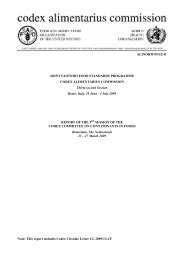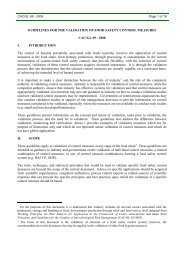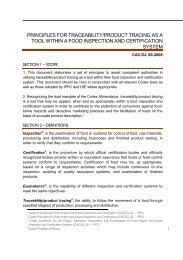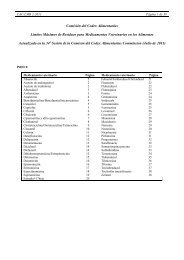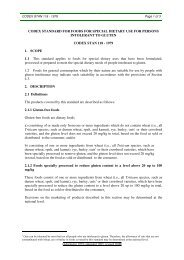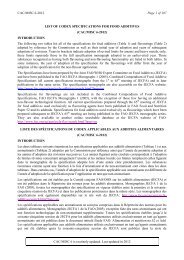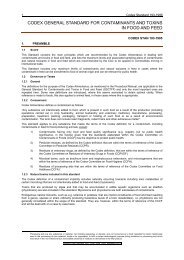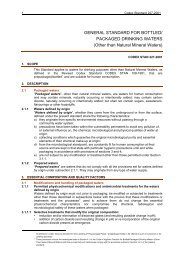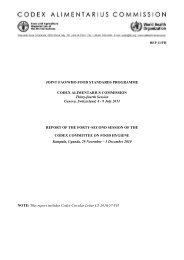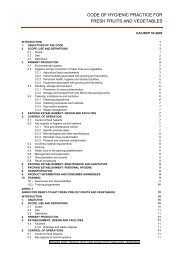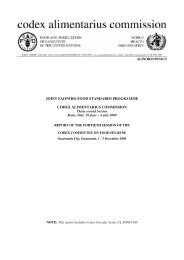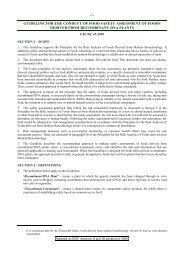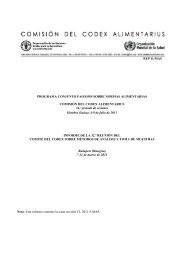General Standard for Food Additives - CODEX Alimentarius
General Standard for Food Additives - CODEX Alimentarius
General Standard for Food Additives - CODEX Alimentarius
You also want an ePaper? Increase the reach of your titles
YUMPU automatically turns print PDFs into web optimized ePapers that Google loves.
<strong>CODEX</strong> STAN 192-1995 Page 46 of 287<br />
14.2.5 Mead:<br />
86<br />
Alcoholic liquor made from fermented honey, malt and spices, or just of honey. Includes honey wine.<br />
14.2.6 Distilled spirituous beverages containing more than 15% alcohol:<br />
Includes all distilled spirituous beverages derived from grain (e.g., corn, barley, rye, wheat), tubers (e.g.,<br />
potato), fruit (e.g., grapes, berries) or sugar cane that contain greater than 15% alcohol. Examples include:<br />
aperitifs, brandy (distilled wine), cordials, liqueurs (including emulsified liqueurs), bagaceira belha (grappa<br />
from Portugal; bagaceira is a drink distilled from bagaço (pressed skins, seeds and stalks of the grapes)), eau<br />
de vie (a brandy), gin, grappa (Italian brandy distilled from the residues of pressed wine), marc (brandy<br />
distilled from grape or apple residue), korn (grain spirit (schnapps) of Germany, usually derived from rye<br />
(Roggen), sometimes from wheat (Weizen) or both (Getreide); also labelled as Kornbrantt or<br />
89<br />
Kornbranttwein) , mistela (also mistelle (France) and jeropico (South Africa); unfermented grape juice<br />
<strong>for</strong>tified with grape alcohol), ouzo (Greek spirit drink flavoured with aniseed), rum, tsikoudia (grape marc<br />
spirit from Crete), tsipouro (grape marc spirit from certain regions in Greece), wienbrand (style of grape<br />
89<br />
brandy devised by Hugo Asbach, Rudesheim, Germany; literally, “burnt wine”) , cachaça (Brazilian liquor<br />
90 86,91,92<br />
made from fermented distilled sugar cane juice) , tequila, whiskey, and vodka.<br />
14.2.7 Aromatized alcoholic beverages (e.g., beer, wine and spirituous cooler-type beverages, low-alcoholic<br />
refreshers):<br />
Includes all non-standardized alcoholic beverage products. Although most of these products contain less than<br />
15% alcohol, some traditional non-standardized aromatized products may contain up to 24% alcohol.<br />
Examples include aromatized wine, cider and perry; aperitif wines; americano; batidas (drinks made from<br />
90<br />
cachaça, fruit juice or coconut milk and, optionally, sweetened condensed milk) ; bitter soda and bitter<br />
vino; clarea (also claré or clary; a mixture of honey, white wine and spices; it is closely related to hippocras,<br />
which is made with red wine); jurubeba alcoholic drinks (beverage alcohol product made from the Solanum<br />
paniculatum plant indigenous to the north of Brazil and other parts of South America); negus (sangria; a hot<br />
drink made with port wine, sugar, lemon and spice); sod, saft, and sodet; vermouth; zurra (in Southern Spain,<br />
a sangria made with peaches or nectarines; also the Spanish term <strong>for</strong> a spiced wine made of cold or warm<br />
wine, sugar, lemon, oranges or spices); amazake (a sweet low-alcoholic beverages (



